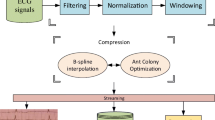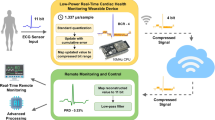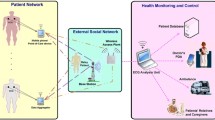Abstract
In the study of electrocardiogram signal monitoring systems, signal compression techniques for effective signal transmission and abnormal beat detection for arrhythmia diagnosis are paramount areas. The general abnormal beat detection has a problem of unsuitability for low-power and low-capacity embedded devices because it requires reconstructing a compressed signal to generate an auxiliary signal for fiducial point (FP) detection. In this study, we propose a method to compress signals into a small number of vertices, including the FP, using an optimized dynamic programming-based linear approximation. Then, we detect the FP from the vertices and classify the abnormal beat. The proposed method minimizes the amount of memory usage and computation by detecting the FP using the vertex’s feature value without reconstructing the compressed signal. The signal compression performance of the proposed method showed an average compression ratio of 7.05:1 and a root-mean-square difference of 0.78% for 48 records of the MIT-BIH arrhythmia database. In addition, the premature ventricular contraction abnormal beat detection performance using only QR interval feature showed 84.07% sensitivity and 93.70% accuracy; when R-peak’s amplitude and RR interval features were added, the sensitivity and accuracy increased to 96.65% and 93.76%, respectively. Therefore, we confirmed that the proposed method could effectively compress electrocardiogram signals based on linear approximation and detect abnormal beats without signal reconstruction.














Similar content being viewed by others
Explore related subjects
Discover the latest articles, news and stories from top researchers in related subjects.References
Arshad A, Khan S, Alam AHMZ, Tasnim R, Boby RI (2016) Health and wellness monitoring of elderly people using intelligent sensing technique. In: 2016 international conference on computer and communication engineering (ICCCE), pp 231–235. https://doi.org/10.1109/ICCCE.2016.58
Bellman R, Dreyfus S (2015) Applied dynamic programming. Princeton Legacy Library, Princeton University Press, Princeton
Bera P, Gupta R, Saha J (2020) Preserving abnormal beat morphology in long-term ECG recording: an efficient hybrid compression approach. IEEE Trans Instrum Meas 69:2084–2092. https://doi.org/10.1109/TIM.2019.2922054
Huszar RJ (2007) Basic dysrhythmias: interpretation and management. Mosby Jems/Elsevier, Maryland Heights
Illanes-Manriquez A, Zhang Q (2008) An algorithm for robust detection of QRS onset and offset in ECG signals. In: 2008 computers in cardiology, pp 857–860. https://doi.org/10.1109/CIC.2008.4749177
James AP (2015) Heart rate monitoring using human speech spectral features. Hum Centric Comput Inf Sci 5:1–12. https://doi.org/10.1186/s13673-015-0052-z
Laguna P, Jané R, Caminal P (1994) Automatic detection of wave boundaries in multilead ecg signals: validation with the cse database. Comput Biomed Res 27:45–60. https://doi.org/10.1006/cbmr.1994.1006
Lee S, Park D (2020) Enhanced dynamic programming for polygonal approximation of ECG signals. In: 2020 IEEE 2nd global conference on life sciences and technologies (LifeTech), pp 121–122. https://doi.org/10.1109/LifeTech48969.2020.1570620076
Lee S, Park D (2021a) Improved dynamic programming in local linear approximation based on a template in a lightweight ECG signal-processing edge device. J Inf Process Syst 18(1):97–114. https://doi.org/10.3745/JIPS.03.0173
Lee S, Park D (2021b) A real-time abnormal beat detection method using template cluster for ECG diagnosis on IoT devices. Hum Cent Comput Inf Sci. https://doi.org/10.22967/HCIS.2021.11.004
Lee S, Park D, Park KH (2017) QRS complex detection based on primitive. J Commun Netw 19:442–450. https://doi.org/10.1109/JCN.2017.000076
Lee S, Jeong Y, Park D, Yun BJ, Park KH (2018) Efficient fiducial point detection of ECG QRS complex based on polygonal approximation. Sensors 18:1–16. https://doi.org/10.3390/s18124502
Lee W, Kim N, Lee B (2019a) An adaptive transmission power control algorithm for wearable healthcare systems based on variations in the body conditions. J Inf Process Syst 15(3):593–603. https://doi.org/10.3745/JIPS.03.0118
Lee S, Jeong Y, Kwak J, Park D, Park KH (2019b) Efficient communication overhead reduction using polygonal approximation-based ECG signal compression. In: 2019b international conference on artificial intelligence in information and communication (ICAIIC), pp 058–061. https://doi.org/10.1109/ICAIIC.2019b.8668974
Lee S, Jeong Y, Kwak J, Park D, Park KH (2019c) Advanced real-time dynamic programming in the polygonal approximation of ECG signals for a lightweight embedded device. IEEE Access 7:1628501–2162861. https://doi.org/10.1109/ACCESS.2019.2952399
Li A, Wang S, Zheng H, Ji L, Wu J (2010) A novel abnormal ECG beats detection method. In: 2010 the 2nd international conference on computer and automation engineering (ICCAE), pp 47–51. https://doi.org/10.1109/ICCAE.2010.5452002
Lin HY, Liang SY, Ho YL, Lin YH, Ma HP (2014) Discrete-wavelet-transform-based noise removal and feature extraction for ECG signals. IRBM 35:351–361. https://doi.org/10.1016/j.irbm.2014.10.004
Madeiro JP, Cortez PC, Marques JA, Seisdedos CR, Sobrinho CR (2012) An innovative approach of QRS segmentation based on first-derivative, hilbert and wavelet transforms. Med Eng Phys 34:1236–1246. https://doi.org/10.1016/j.medengphy.2011.12.011
Manriquez AI, Zhang Q (2007) An algorithm for QRS onset and offset detection in single lead electrocardiogram records. Annu Int Conf IEEE Eng Med Biol Soc. https://doi.org/10.1109/IEMBS.2007.4352347
Martinez A, Alcaraz R, Rieta JJ (2010) Application of the phasor transform for automatic delineation of single-lead ECG fiducial points. Physiol Meas 31:1467–1485. https://doi.org/10.1088/0967-3334/31/11/005
Meng Y, Yi S, Kim H (2019) Health and wellness monitoring using intelligent sensing technique. J Inf Process Syst 15(3):478–491. https://doi.org/10.3745/JIPS.04.0115
Moddy GB, Mark RG (1990) The MIT-BIH arrhythmia database on CD-ROM and software for use with it. In: Proceedings computers in cardiology, pp 185–188. https://doi.org/10.1109/CIC.1990.144205
Mohd Apandi ZF, Ikeura R, Hayakawa S, Tsutsumi S (2020) An analysis of the effects of noisy electrocardiogram signal on heartbeat detection performance. Bioengineering 7(2):53. https://doi.org/10.3390/bioengineering7020053
Mokhtarian F, Suomela R (1998) Robust image corner detection through curvature scale space. IEEE Trans Pattern Anal Mach Intell 20:1376–1381. https://doi.org/10.1109/34.735812
O’Connell KJ (1997) Object-adaptive vertex-based shape coding method. IEEE Trans Circuits Syst Video Technol 7:251–255. https://doi.org/10.1109/76.554440
Ou Y, Li X, Guo Z, Wang Y (2020) Anobeat: anomaly detection for electrocardiography beat signals. In: 2020 IEEE fifth international conference on data science in cyberspace (DSC), pp 142–149. https://doi.org/10.1109/DSC50466.2020.00029
Ozdemir MA, Guren O, Cura OK, Akan A, Onan A (2020) Abnormal ECG beat detection based on convolutional neural networks. In: 2020 medical technologies congress (TIPTEKNO), pp 1–4. https://doi.org/10.1109/TIPTEKNO50054.2020.9299260
Pan J, Tompkins WJ (1985) A real-time QRS detection algorithm. IEEE Trans Biomed Eng BME-32:230–236. https://doi.org/10.1109/TBME.1985.325532
Rhim H, Tamine K, Abassi R et al (2018) A multi-hop graph-based approach for an energy-efficient routing protocol in wireless sensor networks. Hum Cent Comput Inf Sci. https://doi.org/10.1186/s13673-018-0153-6
Teraoka T (2012) Organization and exploration of heterogeneous personal data collected in daily life. Hum Cent Comput Inf Sci. https://doi.org/10.1186/2192-1962-2-1
Yazdani S, Vesin JM (2016) Extraction of QRS fiducial points from the ECG using adaptive mathematical morphology. Digit Signal Process 56:100–109. https://doi.org/10.1016/j.dsp.2016.06.010
Zigel Y, Cohen A, Katz A (2000) The weighted diagnostic distortion (WDD) measure for ECG signal compression. IEEE Trans Biomed Eng 47(11):1422–1430. https://doi.org/10.1109/TBME.2000.880093
Acknowledgements
This work was supported in part by the Institute of Information and Communications Technology Planning and Evaluation (IITP) grant funded by the Korea Government (MSIT), Metamorphic Approach of Unstructured Validation/Verification for Analyzing Binary Code, under Grant 2021-0-00944, 60%, in part by the Ministry of Education through the BK21 FOUR Project under Grant 4199990113966, 10%, in part by the National Research Foundation of Korea (NRF) funded by the Ministry of Education through the Basic Science Research Program under Grant NRF-2020R1I1A1A01072343, 20%, and Grant NRF-2018R1A6A1A03025109, 10%.
Author information
Authors and Affiliations
Corresponding author
Additional information
Publisher's Note
Springer Nature remains neutral with regard to jurisdictional claims in published maps and institutional affiliations.
Rights and permissions
About this article
Cite this article
Lee, S., Park, D. Abnormal beat detection from unreconstructed compressed signals based on linear approximation in ECG signals suitable for embedded IoT devices. J Ambient Intell Human Comput 13, 4705–4717 (2022). https://doi.org/10.1007/s12652-021-03578-y
Received:
Accepted:
Published:
Issue Date:
DOI: https://doi.org/10.1007/s12652-021-03578-y




